13 min read
Curly Hair Chronicles: Types, Care, Styling & Best Basic Curl Routine
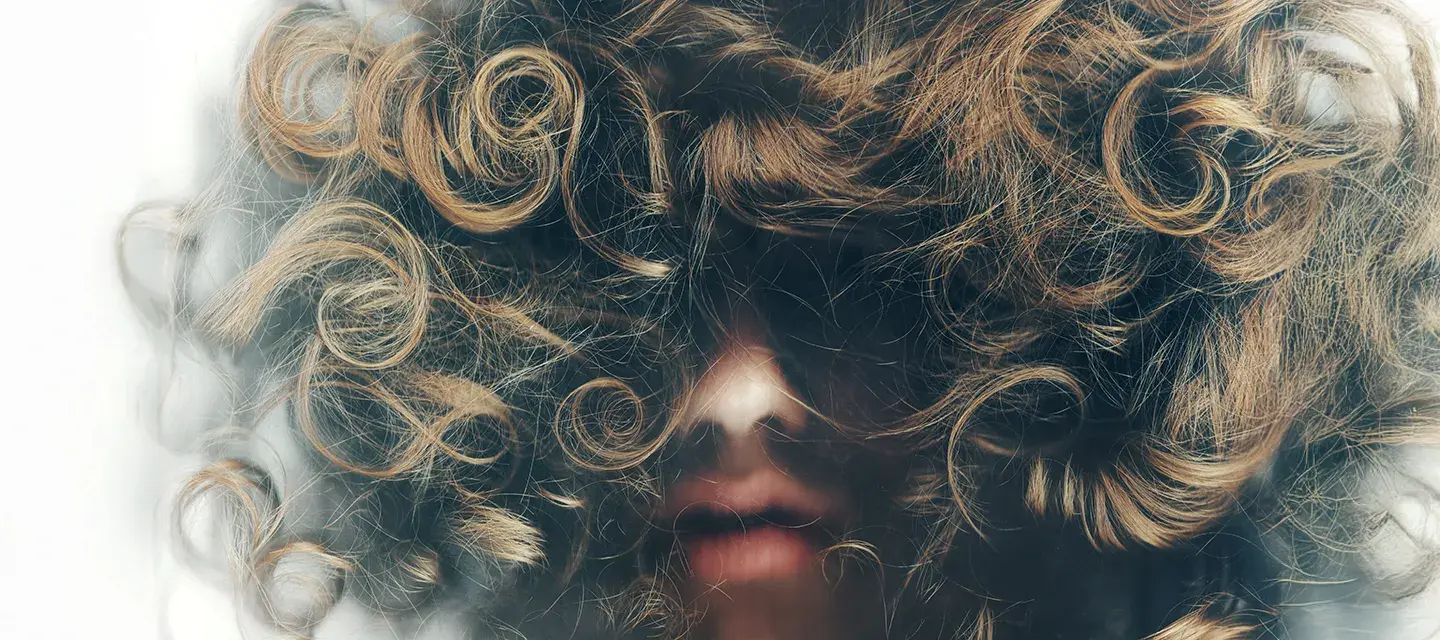
"I am looped in the loops of her hair." Yeats wrote as the 20th century dawned, celebrating the desire for maddening love and lust of the honeymoon phase. This made curly hair owneresses everywhere smirk with the smug grandeur of the coveted hairstyle bestowed upon them by nature. A curse, set on our heads to remind us that we can’t control everything, is also a blessing that can easily provide a lifetime of good hair days if properly cared for.
So if you want some of those proper lovin’ tips for all curly hair types, you’ll have to go and dig around the Internets for tricks on curly hair care, from authority sources like the AAD or personal experiences from your curl sisters. We’re never actually sure if the tips will work exactly for our hair, so we can’t promise it here in the curly chronicles today, either. Although we can go through basic types of curly hair, each head is as unique as the person wearing it, and you may need to find your own way and go by evolution's favorite method of trial and error until you find what works for the reality of your life and specific type of curl.
Curls, ringlets, and a strong-headed personality, whether you have soft wavy curly hair, springy coily hair, or voluminous curly wavy hair, caring for textured hair requires a tailored approach and styles that agree with curly hair. Consider this guide a basic set of colors in your repertoire, which you can mix and match to create any imaginable nuance the eye can see, and treat it as a strong foundation to build a personal curly hair routine for beautiful and strong hair. We’ll talk about curl types, curly hair care, styling routines, and even how to get curly hair without heat, for all those who’d like to loop their lovers in the luscious loops of their hair. Consider this your forever-bookmarkable cheat sheet.
Natural Curly Hair
We’ve envied the straight-haired friends, family, and random strangers. Now we’ve (hopefully) opted out of “the grass is greener” envy, accepted our curls and see them rocked right and left (because they are fabulous and make us look vibrant, youthful, and feminine).
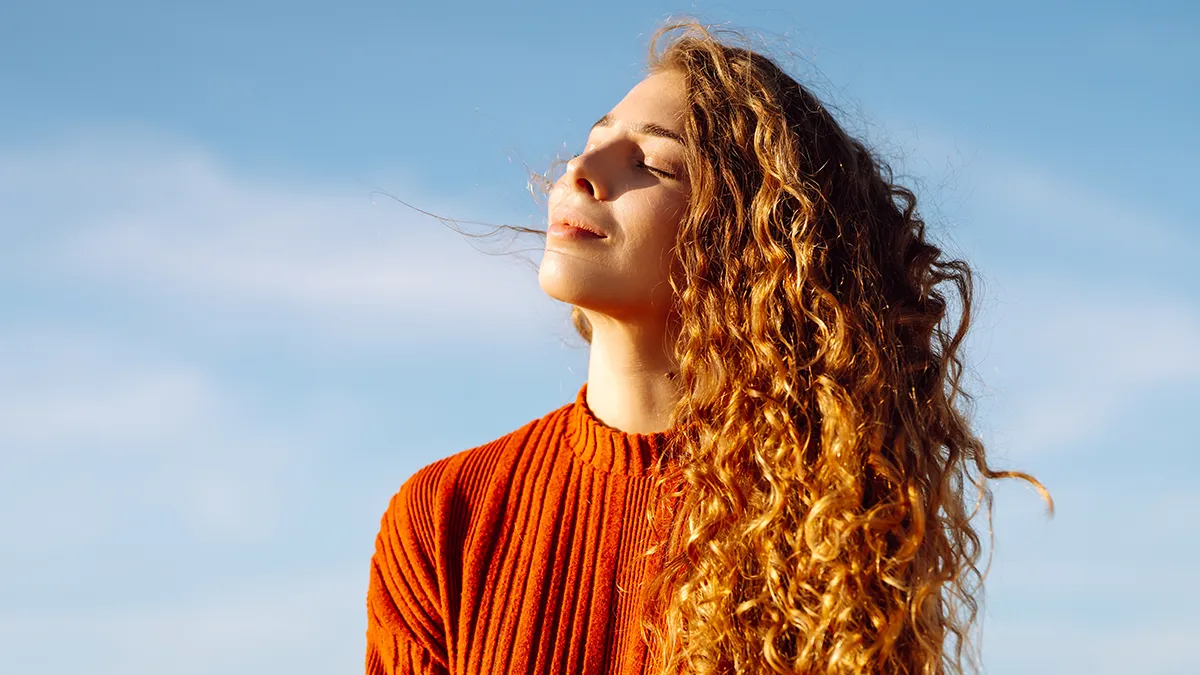
For us, granted these waves and coils naturally, there are some things to know about the structure of strands. At its core, curly hair (and its cousins, coiled hair and soft wavy textures) is a hair structure built very differently from that of straight hair. Left to its own devices, it naturally bends, twists, or forms ringlets with no need for mechanical curling methods or fixators to keep the curls in place. The beauty of curly hair types also comes with trade-offs that we’ll need to offset by knowing how to care for the fibers. Curly hair, in comparison to straight hair, is:
- Drier because natural oils struggle to travel down coils. Plus, we don’t usually brush out our hair when it’s dry (because we end up looking like a messy mushroom or a confused triangle), meaning we do not distribute the beneficial scalp oils along the entire length of the strand.
- More fragile because the twists and bends can create points of weakness, and an uneven shape can lift cuticles, making them more vulnerable to damage. Also, curly hair often has less strengthening keratin in the center of the strand, making it more likely to break off, and the dryness can make it brittle and more susceptible to split ends.
- Higher porosity makes it more responsive to changes in the environmental water content. High humidity can make the strands swell with water, leading to frizz and tangling. In dry air, it can lose its moisture, making it more likely to break.
- Not very happy with man-handling. It needs ample moisture, very gentle handling that lets it take its preferred shape with coaxing rather than force, and curl-friendly products that work with your hair's structure rather than against it.
You need to use these facts as a starting point when choosing the right curly hair products and scalp care items, and build a common-sense, no-nonsense, sustainable curl routine that fits your life and schedule. We’d love to have an extra hour a day in a grand life of leisure to tinker with our hair, but most of us don’t, and we need things that are cost-effective and fast.
There are a lot of us curlies out there, but we’re not all the same, and our hair can need different approaches depending on the exact hair type and subtype.
Curly Hair Types (2–4)
If you’ve ever Googled curl types or types of curly hair (we know you did), you’ve likely stumbled upon the universal classification system of 4 types (developed by Oprah's hair stylist, Andre Walker, for his own hair line) that helps us determine your hair type. Type 1 refers to completely straight hair with no wave. The classification types are as follows:
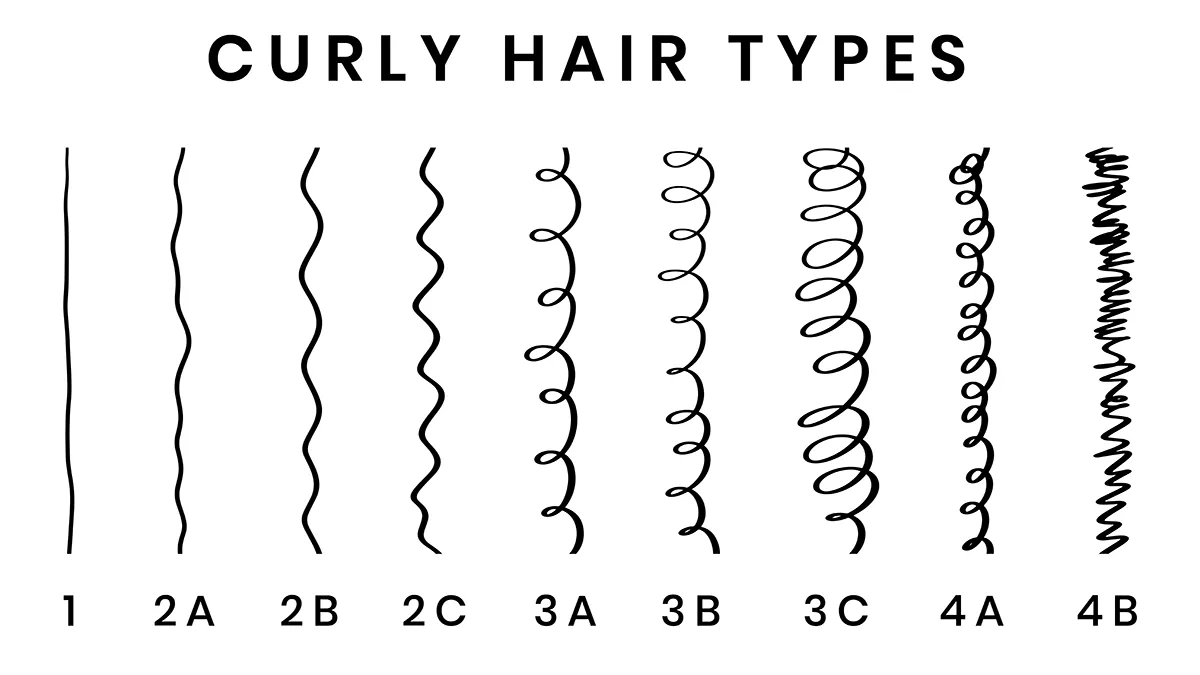
Type 1: Straight
1A: Totally straight and very fine hair, lacks volume, and is difficult to style.
1B: Thicker than 1A, heavier strands with more body and texture.
1C: Straight, thick, and coarse, frizzy hair that can’t be styled into curls no matter how hard you try.
Type 2: Wavy Hair
2A: Straight-leaning, slight “S” shape strands
2B: Beachy look with naturally defined full waves
2C: Almost curly, thick hair that is more prone to frizz than other types B
Type 3: Curly Hair
3A: Big, defined, loose, complete spirals
3B: Tighter ringlets with more volume
3C: Corkscrew curls, dense and voluminous, hold their shape very well
Type 4: Coily / Kinky Hair
4A: Small, springy coils
4B: Angled zig-zag pattern
4C: Tightest curls, highly shrinkage-prone
If it is easier for you to have it explained in detail, our girl below did a pretty good job with no unnecessary chatter.
How to Take Care of Curly Hair (The Basics)
We’ve all made so many mistakes and tortured our hair endlessly. Oh, the time, energy, and money we’ve spent trying to straighten it in our teens and 20s, fearing the slightest tinge of moisture like the plague, and rain was equal to nuclear fallout. The hot irons, scalp-scouring hair dryer heat, and aggressive brush pulls that strained the roots, we did it all. Care means love. Love means not harming (even when it refuses to listen).
A basic curly hair routine means you’ll get obsessively serious about a few key points that will give compound interest if you stick to these: moisture, gentle handling, heat protection, and sleep habits that support hair health. Best curly hair tips are:
1. Moisturize
We’ve mentioned that naturally curly hair is usually drier due to having trouble with distributing natural sebum through the S-shaped or coily strands. This could still mean your scalp is oily, but since we avoid dry brushing for curly and wavy hair types, you’re in quite a pickle. Hair thrives on hydration, and the curlier your hair, the more true this is. Stock your shower shelves with:
- Moisturizing shampoos. The more hydration, the better. A good-quality shampoo developed for curly hair may save you sooo much trouble. Oh, if I had only known.
- Rich conditioners. Keep away from really heavy stuff if you’re a Type 2 as the extra weight could flatten your waves and make your hair get very greasy at the roots fast. You can go as rich and heavy as you’d like with Type 4 tight coils and kinks.
- Creamy leave-ins. Types 3 and 4 may benefit the most from these, as well as from good hair and scalp serums. But if you find a good light leave-in, you can make your waves thrive with Type 2, too.
- Lightweight oils for sealing. We’d recommend using those only on the bottom half of the hair or tips to prevent split ends, rather than coating the entire hair unless you have dehydrated Type 4 hair, which benefits from an extra layer of sealing.
2. No daily washes
We’re obsessed with washing in the modern world, and you’ll often hear people saying they wash their hair daily. This might even have some merit for very straight, fine hair (1A), and there may be situations when it's necessary for a few days in a row, but don’t make it a habit, because the damage is cumulative.
Never in history have people had the chance to wash their hair daily; they never used mass-produced hair products up to the turn of the 20th century, with synthetic detergents entering in the 30s. If you haven’t been heavily perspiring or doing some really dirty chores or spent the day in smog and dust, your hair is not dirty. The sebum is natural and nourishing. Over-washing leads to over-drying of the scalp and strands, which ends in frizzy, curly hair. Aim for:
- 1–3 washes per week. You know how sometimes, on day 2 or 3 after washing your hair, it looks fantastic. This is the result of natural oils giving it some hold and a healthy sheen, but it usually also means the roots are greasier than you’d like. If you were to twirl a lock around your finger, that one would look shinier. You’ve aligned the hairs in it and coated the tips with natural oils from your fingers. Leave the hair unwashed for that extra day if you have no important engagement to be at.
Type 3 and 4 hair is usually drier and will not get visibly greasy in a few days, so you can do a weekly wash and nourish. If you’re a type 2 with particularly fine hair and a greasier scalp, washing every 2-3 days is fine. We want to remove visible sebum without stripping the scalp completely. Daily washing, even with a gentle shampoo, might push your scalp into overcompensation mode, where it tries to replace the rinsed-away sebum more quickly to protect itself, resulting in hair that gets greasier even faster. If you’ve washed your hair in the morning and it’s very greasy in the evening, this might be the cause. - Hydrating, sulfate-free formulas. The more often you wash your hair, the gentler the shampoo must be. Sulfates can strip away natural oils, making it more difficult for curly hair (which already has some trouble with it) to retain essential moisture. If your shampoo has sulfates, you’re more likely to end up with less defined curls and frizzy curly hair. Sulfates can also fade colored hair faster, further damage chemically processed hair (like perms), and irritate sensitive scalps, and redness or itching does not seem like a fun time.
- Conditioners with “slip” for easy detangling. Have you seen those people with straight hair just running their brush from root to tip, without a care in the world? No resistance, tangles, or unexplained knots that defy the laws of physics, while folks can lose their entire hand and get trapped in the labyrinth of our hair. We can’t do that. We can’t even just do wet detangling, but need a quality conditioner to provide adequate slip, not to risk breaking strands of the Gordian knots gracing our skulls. Getting a serious hair detangler should also be at the top of your hair priority list.
We recommend: FLIP™ play advanced LED light hairbrush, combining the best a detangler has to offer and a simple but effective blue, green, and red LED light therapy.
- 3 LED colors: Red reduces breakage, blue calms the scalp, and green revitalizes hair follicles.
- Advanced anti-static finish: Bristles easily glide in all hair types for a glossy finish, no frizz or flyaways.
- Less breakage: Strategically spaced TPEE bristles gently separate hair and minimize mechanical damage, especially on wavy and curly hair (Type 2 and Type 3)
- Protective frame: Flips forward to protect the brush from damage and lint while in a bag or drawer.
- Smart Swedish design: To be used on wet and dry hair, app-connected, battery life up to 6 Hrs/charge.

4. Dry gently
We all do it. We’re too lazy to spend a minute more gently drying, so we towel-rub the soul out of our hair. The rougher the towel, the better we like it (it feels good against the scalp, like a mini-massage). But what you’re doing here is basically destroying your curl pattern, breaking strands, and creating those physics-defying micro tangles that will grow into full-blown dreadlocks over the course of the next couple of days. As a bonus, rough drying will give you enviable frizz, and those little baby hairs (all hail the baby hairs) will disregard gravity completely.
Swap your rough towels for fancy microfiber towels, or just do the easier thing: use a soft old T-shirt to blot your hair dry(er). Ideally, you’d like not to disturb the natural clumps of strands forming, so scrunch upwards to keep the curls consistent and reduce frizz, and don’t give yourself noogies on the scalp.
5. Avoid brushing when dry
If you’ve tried brushing out your hair dry, you’ve been unpleasantly surprised with the results and regretted it instantly. Only detangle when your hair is wet and generously coated in conditioner. Start at the ends and work upward to the roots to minimize breakage and make the experience far more pleasant and faster. If you’ve got a lot of hair, you can first do coarse detangling with your fingers or section your hair to make it easier for the detangler brush to glide.
If you will be using any hot styling tools (to get your hair straight that day or to define and make curls more uniform), always apply a heat protectant. Don’t skip it, as your already dry hair will get damaged much faster than the straight thick hair that has more moisture and no weak bend points due to natural twists, turns, zigs, and zags.
7. Sleep smart
Most pillow cases are cotton or cotton blends. Breathable, comfortable, and can be washed at high temperatures, but these will also cause strand-breaking friction. Silk or satin pillowcases help preserve curl shape and prevent friction-induced frizz, and we all know it. And people centuries ago knew that sleeping with a slippery nightcap makes your hair look better in the morning and in the long run.
We totally understand that replacing all of your pillowcases with silk ones may be a Ritchie Ritch posh moment, so why not just invest in a single bonnet? Heaven knows your partner couldn’t care less about a pillowcase because the bed means sleep (and fun) time.
How to Curl Hair without Heat?
Waves are unstructured or loose, you’ve recently discovered you actually have curly hair when you’ve stopped abusing it, or you have straight hair but admire a good curl, and would like to join the club but abhor scourging your hair with heat)? Here are some heat-free ways to encourage curl formation:
• Scrunching
Apply curl cream or mousse to damp hair and scrunch upward. This will work best if you already have some natural wave to the strand, but it will unfortunately not do anything for pencil-straight hair.
• Braids
For loose waves, like you’ve just spent a day at the beach, braid damp hair and leave it overnight. You’ll get a nice Type B2 wave, and if your hair isn't stubbornly and decisively straight, you’ll keep some wave and texture up to your next wash.
• Twists
Twist sections of damp hair, then air-dry or diffuse. This will form more of a loose ringlet than a wave.
• Flexi rods
Perfect for tighter, uniform curls without heat. You can also roll damp hair onto a soft fabric strip (or even socks), tie the fabric near the scalp, and let your hair air-dry.
Curly Hair Routine: Easy Step-by-Step Guide
We’ve gone through all of these already, but here is your quick go-to for a great (and totally doable, will-not-take-over-your-life) curl routine:
- Hydrating shampoo (1-3 times/week)
- Conditioner + wet detangling
- Leave-in conditioner (optional)
- Curl cream for moisture and definition
- Gel or mousse for hold (if you need it)
- Scrunching or finger-coiling (for better control over strands)
- Diffusing on low heat, or air-drying

Curly Hair Products
This routine reduces frizz, defines curls, and brings out the best in long curly hair, short curls, or medium-length textures. Basics are hydration, definition, hold, and minimal to no heat.
When looking for curly hair products for defined curls and coils that will look shiny while deeply nourishing and protecting, choose products that are:
- Sulfate-free (we’ve covered this)
- Silicone-optional (can provide shine, frizz control, and heat protection, but non-water-soluble silicones can cause buildup, weighing curls down, and blocking moisture absorption)
- Moisture-rich (as curls have a harder time retaining moisture)
- Products designed specifically for your type of curly hair or coily hair (to take 90% of the guesswork out of the equation)
- Avoid heavy waxes and drying alcohols
The Final Loophole
When all the cows have happily come home, curly hair is more a lifestyle than a hairstyle and can be a gratifying long-term relationship if done right. The spirals, ringlets, corkscrews, and bends that defy gravity and logic all bow to an essential toolkit: deep moisture, gentle handling, wet detangling, air- or diffuser-drying on low heat, and rich yet lightweight leave-ins. Your job is to enable and protect the innate logic of your specific hair and curl type. Trial and error isn’t a punishment here; it’s the doorway to mastery. You and I may have the same hair type and subtype, but our hair may react differently to identical handling or need something different as circumstances change, like humidity.
So study these fundamentals until you can twirl them around your finger and treat your hair as an art form. It is such a gorgeously complex universe of its own that Pixar spent 3 years perfecting Merida’s hair. Celebrate every texture, every spiral, every stubborn halo of frizz, and learn from it until you get it right. We hope you’ve gotten some valuable info here. Stay cool, curious, and beautiful, and have a good hair day.
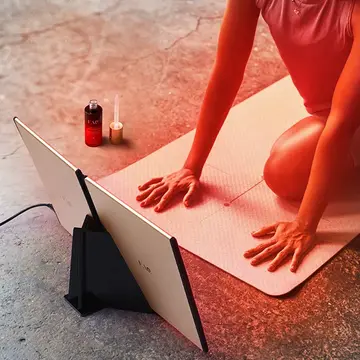






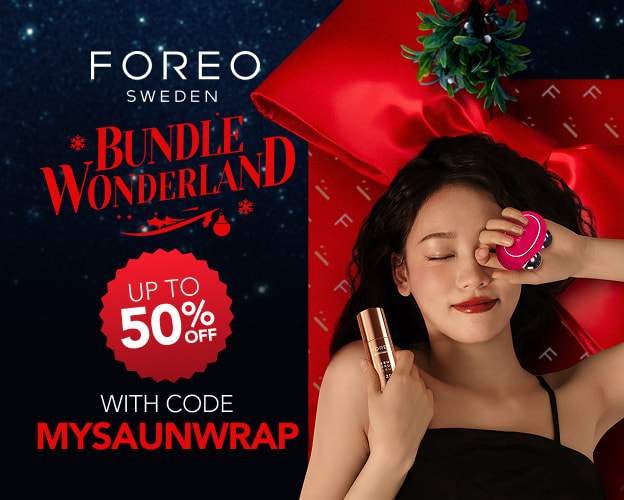
Leave a comment